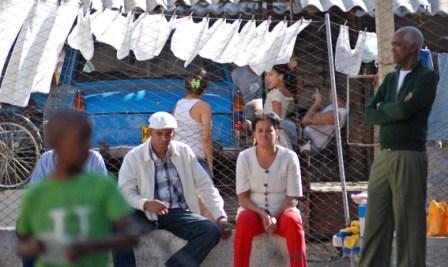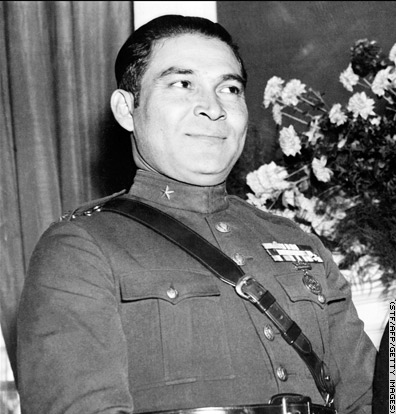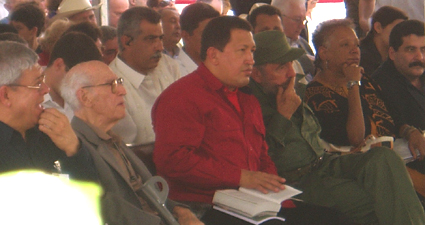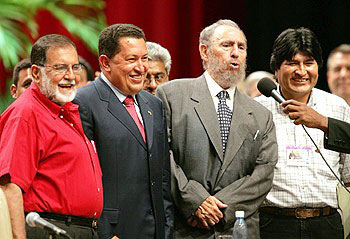On Wednesday December 17, the United States admitted that its attempt to bully Cuba into submission had failed. This should be seen as a victory for the Cuban Revolution and its resilience against the relentless onslaught of the most powerful imperialist power on earth only 90 miles away from its shores. However, US imperialism has not given up on its aims: the restoration of the rule of private property and the destruction of the gains of the revolution. It has just changed the means to achieve the same result.
The announcement of the reestablishment of diplomatic relations between the two countries came after many months of secret negotiations and was finally confirmed in a phone conversation between Raúl Castro and Barack Obama on Monday 15. As part of the agreement, Cuba released US spy Alan Grossman, on humanitarian grounds, as well as another unnamed US spy, and the US released the remaining 3 of the Cuban 5, jailed in the US for the crime of having told the FBI of terrorist actions being planned from US soil by Cuban reactionary emigres.
 The statement from the White House announcing the change of policy starts with a clear admission of bankruptcy: “A Failed Approach. Decades of U.S. isolation of Cuba have failed to accomplish our objective of empowering Cubans to build an open and democratic country.” Of course, where it says an “open and democratic country” what they really mean is a capitalist country, where “democracy” is just a fig leaf for the rule of big corporations.
The statement from the White House announcing the change of policy starts with a clear admission of bankruptcy: “A Failed Approach. Decades of U.S. isolation of Cuba have failed to accomplish our objective of empowering Cubans to build an open and democratic country.” Of course, where it says an “open and democratic country” what they really mean is a capitalist country, where “democracy” is just a fig leaf for the rule of big corporations.
And the statement continues by making clear what were their aims for nearly 55 years and how they failed: “Though this policy has been rooted in the best of intentions, it has had little effect – today, as in 1961, Cuba is governed by the Castros and the Communist party.”
 Fulgencio Batista y Zaldívar was the dictator of Cuba until 1959This cannot be underestimated. Washington has pursued a criminal policy against the Cuban revolution ever since it overthrew the US sponsored dictatorship of Batista. This assault included sponsoring invasions, a commercial, economic, and financial embargo, terrorism, assassination attempts, financing of “dissidents”, a constant barrage of propaganda, destabilisation attempts, etc. The cost of these policies of imperialist aggression has been huge. According to the Cuban government, the embargo costs the small island US$685 million every year.
Fulgencio Batista y Zaldívar was the dictator of Cuba until 1959This cannot be underestimated. Washington has pursued a criminal policy against the Cuban revolution ever since it overthrew the US sponsored dictatorship of Batista. This assault included sponsoring invasions, a commercial, economic, and financial embargo, terrorism, assassination attempts, financing of “dissidents”, a constant barrage of propaganda, destabilisation attempts, etc. The cost of these policies of imperialist aggression has been huge. According to the Cuban government, the embargo costs the small island US$685 million every year.
Even as recently as September this year several European banks were fined hundreds of thousands of US dollars for violating the US embargo on Cuba. German bank Commerzbank was fined over US$1bn in two separate decisions and the French bank BNP Paribas another US$9bn (though the fine also included violating sanctions on Sudan and Iran).
Diplomatic relations between the two countries were broken by the United States in January 1961 after the Cubans demanded the scaling back of the US diplomatic mission, which was involved in terrorist activities against the new revolutionary government. The embargo, which has not yet been removed, as Raúl Castro pointed out, had already started in 1960 in response to the revolution’s expropriation of US property. Before the revolution, US companies controlled 70% of the land and three quarters of primary industry.
For three decades, the combination of the enormous advances of the revolution in the fields of health care, housing, education and others, alongside very favourable trade links with the Soviet Union allowed the revolution to survive this assault. It has to be added that the relationship also meant a bureaucratisation of the Cuban revolution.
After the collapse of the Soviet Union however, the small island was left to its own devices. The Special Period (1991-94) witnessed an economic collapse without precedents as Cuba was left at the mercy of the world market. The fact that despite all the difficulties the revolution did not collapse and capitalism was not restored was a clear indication that the Cuban revolution was still alive and had enormous reserves of support amongst the masses. There was a generation which remembered how life was before the revolution, under the jackboot of US puppet dictators, and what had been won through the abolition of private property. The resistance was not only economic but also political against the massive propaganda campaign of the ruling class internationally to say that socialism had died and there was no alternative to capitalism.
 Hugo Chavez and Fidel CastroThe coming to power of the Bolivarian revolution in 1998 threw a new life line to Cuba. On the one hand, it meant the exchange of Venezuelan oil for Cuban medical services on very favourable terms. On the other, it broke the isolation of the Cuban revolution and provided the hope that it could spread even further.
Hugo Chavez and Fidel CastroThe coming to power of the Bolivarian revolution in 1998 threw a new life line to Cuba. On the one hand, it meant the exchange of Venezuelan oil for Cuban medical services on very favourable terms. On the other, it broke the isolation of the Cuban revolution and provided the hope that it could spread even further.
The collapse of the Soviet Union also brought sharply to the fore the fundamental problem facing the Cuban revolution: its isolation. The Cuban economy, despite the limitations imposed by the embargo, is inserted in the world market on very unfavorable terms. It acquires hard currency by selling nickel and medical services, through tourism and remittances which then it has to use to buy at full market price almost everything (from heavy machinery to food). As with any other underdeveloped economy, with low productivity of labour and outdated machinery in most sectors, the terms of trade extract a heavy toll.
 It is in this context that significant sections of the leadership in Cuba have started to toy with the idea that the “Chinese way” (that is, introducing market relations in certain aspects of the economy, while maintaining an overall control on the part of the state) was the way forward. At the end of the day, wasn’t China the fastest growing economy in the world? The problem with this plan is that in China, market mechanisms in certain sectors progressively led to the full restoration of capitalism in the country and the destruction of many of the conquests of the revolution. Cuba, a small island with limited resources, is in a much weaker position than China was when it went back into the world market.
It is in this context that significant sections of the leadership in Cuba have started to toy with the idea that the “Chinese way” (that is, introducing market relations in certain aspects of the economy, while maintaining an overall control on the part of the state) was the way forward. At the end of the day, wasn’t China the fastest growing economy in the world? The problem with this plan is that in China, market mechanisms in certain sectors progressively led to the full restoration of capitalism in the country and the destruction of many of the conquests of the revolution. Cuba, a small island with limited resources, is in a much weaker position than China was when it went back into the world market.
US ruling class changes tactics against the Cuban Revolution
For many years, a section of the ruling class in the US had pointed out the failure of Washington’s approach to attempt to overthrow the Cuban revolution by brute force. They also realised that as Cuba opened certain sectors to foreign investment, US companies were losing out on potentially profitable business opportunities against Canadian and European capitalists. Above all, they argued, US aims (the restoration of capitalism in Cuba) would be best served by a change in tactics, which is what this announcement really means.
The statement from the White House makes this clear: “We know from hard-learned experience that it is better to encourage and support reform than to impose policies that will render a country a failed state… Today, the President announced additional measures to end our outdated approach, and to promote more effectively change in Cuba that is consistent with U.S. support for the Cuban people and in line with U.S. national security interests.”
What this means is that the United States government still considers it has the right to decide the future of Cuba “in line with US national security interests”. Clearly, the “change” that the US ruling class wants to see in Cuba is, on the one hand, the full restoration of private property over the means of production (and with it the destruction of the gains of the revolution) and the establishment of a bourgeois “democracy” that they can control.
If one looks at the detail of the measures adopted by Obama, it is clear that they are aimed at promoting, encouraging and aiding the development of a private capitalist class. Amongst other things, Obama’s statement explains: “The policy changes make it easier for Americans to provide business training for private Cuban businesses and small farmers and provide other support for the growth of Cuba’s nascent private sector. Additional options for promoting the growth of entrepreneurship and the private sector in Cuba will be explored.” The new policy also includes allowing for larger remittances (increasing the limit from $500 to $2000) and the fact that “support for the development of private businesses in Cuba will no longer require a specific license.” This is accompanied by a series of other measures aimed at easing the embargo (allowing the use of US credit cards on the island; allowing US banks to open accounts in Cuba; lifting some of the import/export restrictions; etc).
This is precisely the policy advocated for a long time by a section of the US ruling class: defeat the revolution through the “heavy artillery of cheap commodity prices” that Marx talked about. Just to give an example, ten years ago, one of the directors of the conservative capitalist think tank Cato Institute argued for an end to the embargo and a series of measures which are, almost to the word, the ones announced by Obama yesterday. The article concluded by saying: “The most powerful force for change in Cuba will not be more sanctions, but more daily interaction with free people bearing dollars and new ideas.” (“Four Decades of Failure: The U.S. Embargo against Cuba”).
Capitalist public opinion was prepared for the announcement by an editorial article in the New York Times on Monday (Cuba’s Economy at a Crossroads), which is interesting because it reveals what the thinking is behind these measures. The article points out that there is a split in the Cuban leadership between those it describes as “the Old Guard leaders” who “warn that a liberalized market economy could turn Cuba into a less egalitarian society and provide an opening for the United States to destabilize the government through a flood of private investment” on the one hand, and “reformists, including some of the country’s leading economists, say the current state of the economy is untenable”. The advice of the New York Times? “Washington could empower the reformist camp by making it easier for Cuban entrepreneurs to get external financing and business training.“
Modernising socialism or moving towards a market economy?
This division of opinion in the Cuban leadership is not just a figment of the imagination of NY Times editorial writers, not wishful thinking on the party of the US ruling class. We have warned before that there is a strong current of opinion amongst leading economists who propose as a way forward a series of wide ranging market reforms like the ones which started the process of capitalist restoration in China. Some of these have already been implemented (see here).
One of the most outspoken of these economists is Omar Everleny of the official Centre for the Study of Cuban Economy (CEEC). In an interview with Havana Times on the new foreign investment law, he summed up his approach: “No country can survive on its own resources alone in today’s globalized world – one way or another, they need foreign resources to achieve development. China and Vietnam have demonstrated that one can make massive use of foreign investment and achieve good economic results without losing political control at home.”
Two other prominent CEEC economists, Juan Triana Cordoví and Ricardo Torres Pérez, in analysing the challenges of “policies for economic growth”, reach the conclusion that, “although certain terms are not used, it seems clear that Cuba is heading towards a model more similar to that of a market economy, even though the final aim does not seem to be the transition to a typical capitalist country.” And they list the measures taken to back up that assertion: “This can be seen in a series of spheres such as the growing weight of the non-state sector (private and cooperative), greater decentralisation in decision making for the economic agents as a whole … greater role of the pricing system in the allocation of productive resources, growing role of direct taxation (on the results of productive activity) in state funding, amongst others.”
The problem, as we have argued before, is that these kind of measures acquire a dynamic of their own and, as shown in China, lead directly to the restoration of capitalism. This restoration would destroy the gains of the revolution, particularly in the fields of health care, education and housing.
US imperialist meddling will continue
As well as the battery of economic measures announced by Washington, there is also a promise to remove Cuba from the list of countries which “sponsor terrorism”. Cuba’s presence on the list is particularly scandalous as in fact it has been the US which has helped, protected and funded terrorists acting against the Cuban revolution.
However, the US says openly that it will continue meddling in the internal affairs of Cuba, all in the name of “human rights” and “democracy”. This is what the statement says: “A critical focus of our increased engagement will include continued strong support by the United States for improved human rights conditions and democratic reforms in Cuba. The promotion of democracy supports universal human rights by empowering civil society and a person’s right to speak freely, peacefully assemble, and associate, and by supporting the ability of people to freely determine their future. Our efforts are aimed at promoting the independence of the Cuban people so they do not need to rely on the Cuban state.”
What stinking hypocrisy! The government which is involved in mass spying on its own citizens, torture, the killing of unarmed civilians by its police, repression of its own citizens, invading any country which does not follow its dictates is now talking about democratic rights and independence!
The changes which have taken place amongst the Cuban community in Florida are also a factor in Obama’s calculations. The generation of those who emigrated in the 1960s fleeing the revolution has now been largely replaced by their offspring, who, although fundamentally opposed to the revolution, are more open to the proposed change in tactics. There has also been an influx of a new layer of economic migrants from Cuba, who would like to see restrictions on travel and on remittances lifted. For the first time, public opinion in Florida is now for the lifting of the embargo and the Democrats are ahead of the Republicans. Still, Obama will have a hard time passing measures lifting the embargo through Congress, where the Republicans have a majority. For this reason so far he has relied on his own executive powers.
How can the Cuban revolution face the new challenges?
The current world situation, with an intractable economic crisis of capitalism and the resulting growing questioning of the system, plays in favour of the Cuban revolution. The situation on the island however is one which does not leave much room for manoeuvre. The economic problems resulting from its inequal insertion in the world market are compounded by mismanagement and bureaucracy. The status quo cannot be maintained.
This situation shows that the main danger facing the Cuban revolution comes from the fact that the revolution is still isolated in a small island surrounded by the world capitalist market. This is an unavoidable fact. The whole history of the relationship between Cuba and the Soviet Union, and later with Venezuela, underlines the point that the Cuban revolution, if it is to survive, it cannot remain isolated. Its fate, ultimately, will be decided on the arena of the world class struggle.
That in turn will have a dialectical relationship with the balance of forces inside the island, between those who argue that the way forward is on the road to the market and those who argue that the defence of the gains of the revolution is linked to the defence of the nationalised property forms which made them possible.
Defend the Cuban revolution!
No imperialist intervention!
No capitalist restoration!

